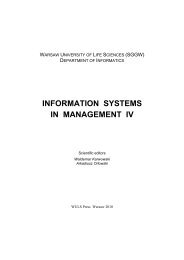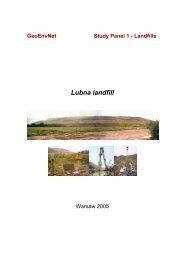ACTA SCIENTIARUM POLONORUM - SGGW
ACTA SCIENTIARUM POLONORUM - SGGW
ACTA SCIENTIARUM POLONORUM - SGGW
You also want an ePaper? Increase the reach of your titles
YUMPU automatically turns print PDFs into web optimized ePapers that Google loves.
Economic sustainability of agriculture – conceptions and indicators 135considerations over the level of social justice and the possible social tensions over incomediscrepancies. The basic task of income policy is solving the income issue structurallyand diminishing the social and economic dysfunctions.To summarise, in order to describe the state of agricultural sustainability in economy,various parities can be measured, i.e. adequate values regarding time are compared – theirconditions, changeability and quality. According to the definition of sustainable agriculture,various elements remain in the state of equilibrium, i.e. they do not create advantagesor disadvantages at the expense of other elements of the system, the time beingtaken into account in analyses. Socio-economic viability of rural communities is one ofthe most important component of sustainable development of agriculture. Its meaning isto receive incomes comparable to those of non-agricultural sectors.CONCLUSIONSThe progress evaluation of the policy of sustainable agriculture requires a holisticapproach, taking into account the whole of interactions between the farming sector andthe national economy, society and the natural environment. Monitoring achievements isincredibly complicated and it requires a constant methodological development. The discussionon farming parity has always been present in relevant literature and the problemremains present. Nowadays, research is more and more commonly multidimensional.Traditional divisions are being replaced by integrative, interdisciplinary research. Incomeissues particularly link economic and social aspects and there is a tendency to use a methodologicalapproach, characteristic for complex social phenomena.The presented considerations do explain the complex issue of sustainable developmentof farming with the use of income parameters. They contribute to further detailedstudies on the rules and aims of sustainable development of agriculture and rural areasand the criteria of evaluating the degree of meeting the aims of its multifunctional development.The following issues has been exemplified on measurement of sustainableagriculture:– Indicators are required at different levels and for different uses. This has important implicationsfor identifying and developing indicators. For example, at local or site specificlevels, more detailed indicators may be required than at more aggregate levels.– There is value in pursuing work to develop and use a core set of agri-environmentalindicators, which are broadly comparable at the international level.– Scale issues are especially important when developing indicators at the national andinternational levels. Indicators must be sensitive to regional variability in both environmentalconditions and farming systems, across and even within countries, becausenational aggregates by themselves can mask variability and thus be misleading.– Indicators must be capable of reflecting both negative externalities (e.g. water pollutionfrom nutrients and pesticides) and positive externalities of agriculture (e.g. provisionof habitat and carbon sinks).– A sound analytical framework which clarifies on linkages and policy objectives isrequired. Indicator sets must also be and remain flexible and adaptive to respond toemerging issues, such as GMOs.Oeconomia 10 (1) 2011
















